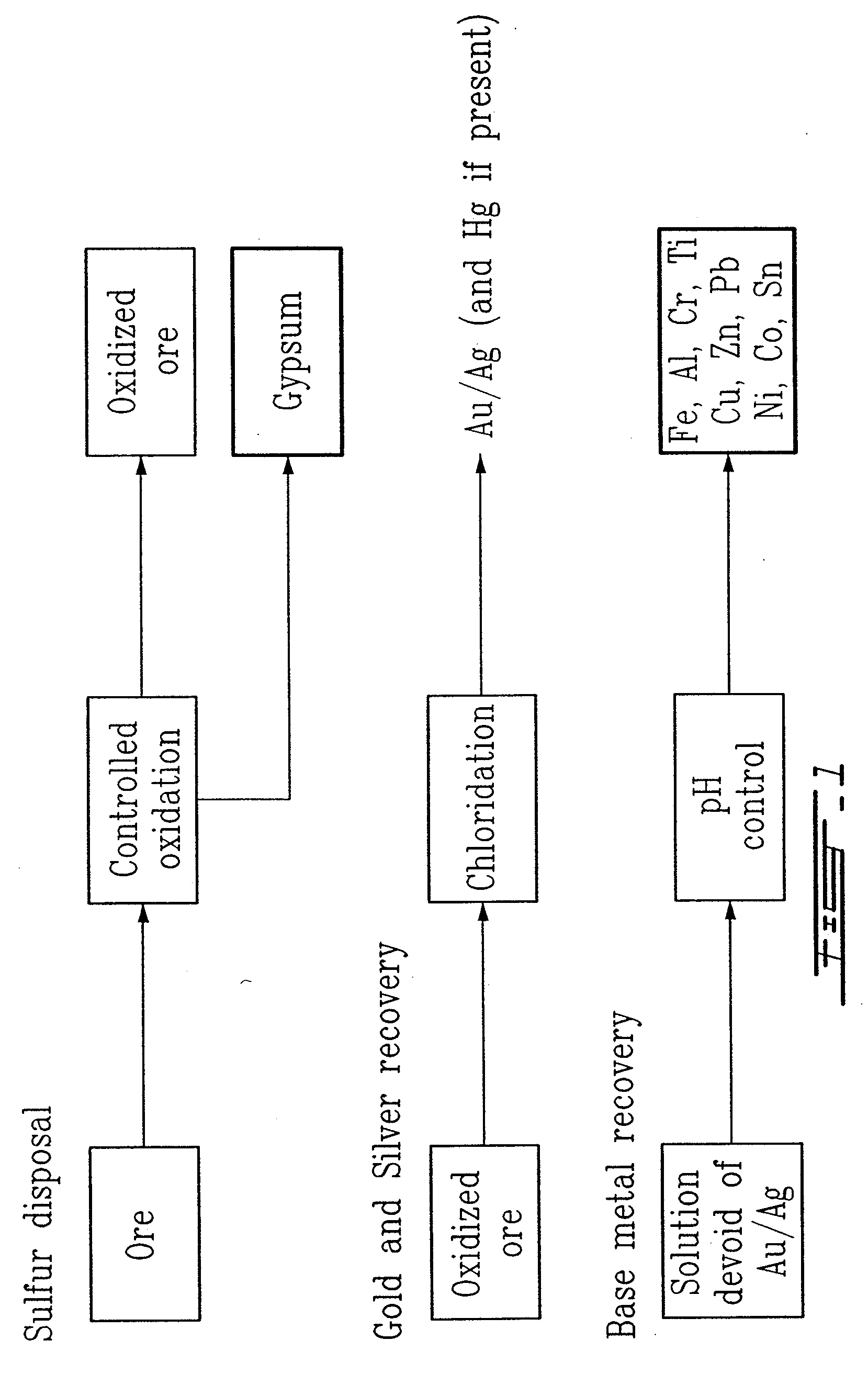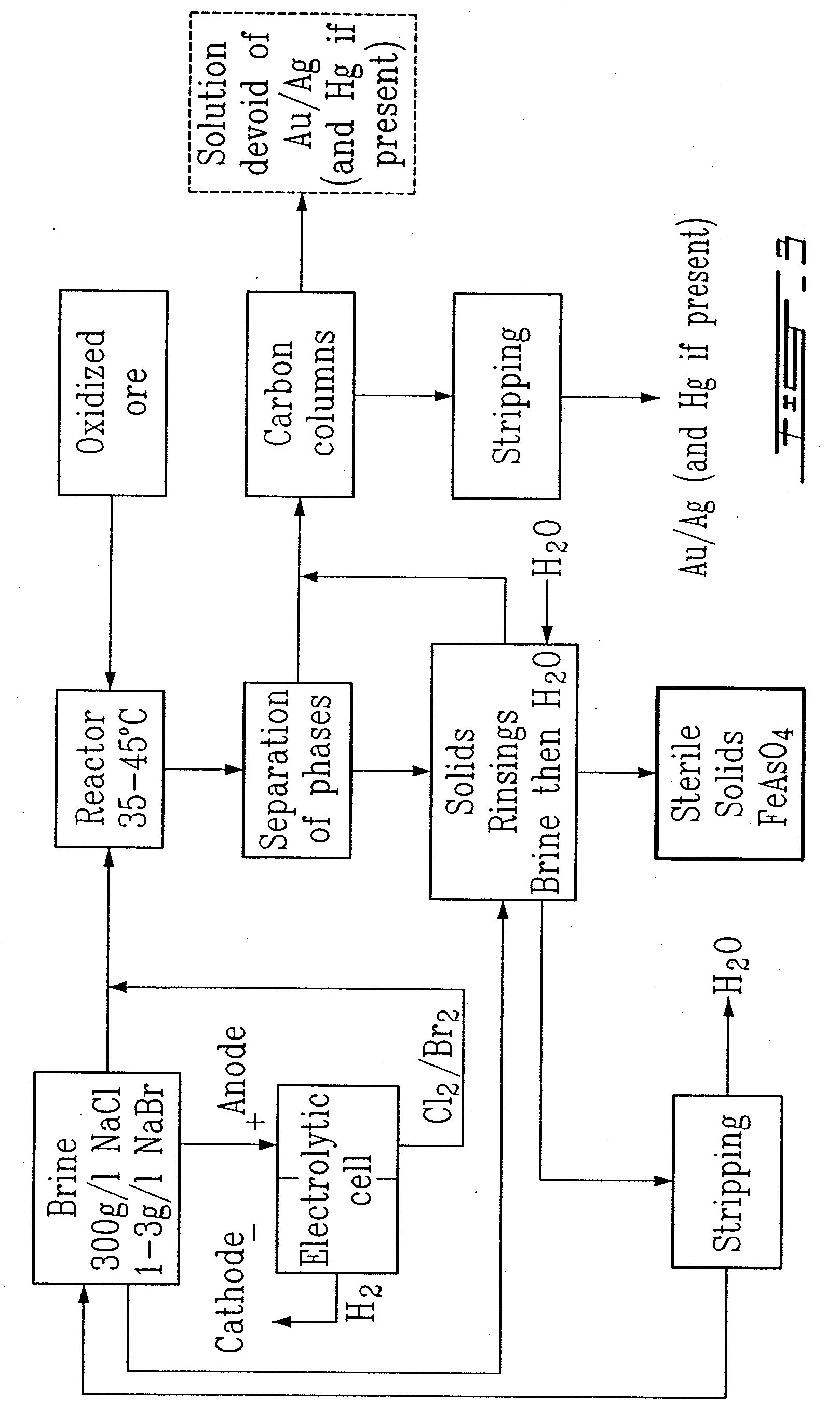Gold and silver recovery from polymetallic sulfides by treatment with halogens
a technology of polymetallic sulfides and halogens, which is applied in the direction of silver compounds, nickel compounds, dissolving, etc., can solve the problems of low efficiency of the process, large volatilization loss of values, and general characteristics of the various processes involving chlorine, either as elemental chlorine or as chloride, either at ambient temperature or at high temperature, and achieves high treatment rates and fast reaction rates.
- Summary
- Abstract
- Description
- Claims
- Application Information
AI Technical Summary
Benefits of technology
Problems solved by technology
Method used
Image
Examples
example 1
[0069]A Canadian ore sample (90 g) from the Sudbury (Ontario) area containing 4.5 g / T Au, 8 g / T Ag, 0.1% As, 7.5% S, 5.5% Fe, 0.1% Ni, 0.008 Co and 0.5% Cu was reduced to a particle size of about 140 mesh and heated at 585-600° C. in an atmosphere composed of N2 (50%) and air (50%), over a period of two hours in a Vycor™ tube heated externally in a Lindberg™ furnace. The temperature was measured inside the mass being oxidized. The external heating was reduced when the oxidation began at around 400° C.
[0070]A small amount of a white deposit, arsenic oxide, could be observed at the discharge side of the Vycor™ tube. The color of the oxidized material changed from black to brown and the weight loss during the process was about 12%.
[0071]A sample of the oxidized material (25.0 g) was placed in a three-necked one liter flask, along with 500 g of water, 150 g of sodium chloride and 1.2 g of sodium bromide. The suspension was stirred magnetically and the flask was closed so as to exclude a...
example 2
[0076]A sample of ground ore (100-200 mesh) from the Pueblo Viejo deposit (100 g), Dominican Republic, and containing 3.0 g / T Au, 2.25 g / T Ag, 0.28% Zn, 0.025% As, 5.8% Fe and 4.9% S (as sulfides) was oxidized at about 600° C. for a period of 2 hours in lean air (about 10% O2).
[0077]The oxidized material was then leached using KCl brine (50.0 g of oxidized ore in 500 mL of KCl brine (200 g KCl / L) containing 2.0 g KBr). The suspension was stirred at 45° C. for a period of two hours, while in the presence of chlorine (0.7 g), added to the slurry at the beginning of the contact.
[0078]The slurry was filtered, the cake rinsed with KCl brine (200 g KCl / L) and then washed with water. The combined brine filtrate, rinsings and washings were analyzed for gold, silver and zinc. The gold recovery was of the order of 87%; the silver recovery was of the order of 61%; and the zinc recovery was of the order of 99%. Essentially all of the arsenic was found in the barren solid, and none was present i...
PUM
| Property | Measurement | Unit |
|---|---|---|
| Temperature | aaaaa | aaaaa |
| Temperature | aaaaa | aaaaa |
| Temperature | aaaaa | aaaaa |
Abstract
Description
Claims
Application Information
 Login to View More
Login to View More - R&D
- Intellectual Property
- Life Sciences
- Materials
- Tech Scout
- Unparalleled Data Quality
- Higher Quality Content
- 60% Fewer Hallucinations
Browse by: Latest US Patents, China's latest patents, Technical Efficacy Thesaurus, Application Domain, Technology Topic, Popular Technical Reports.
© 2025 PatSnap. All rights reserved.Legal|Privacy policy|Modern Slavery Act Transparency Statement|Sitemap|About US| Contact US: help@patsnap.com



